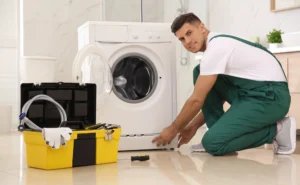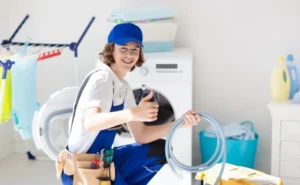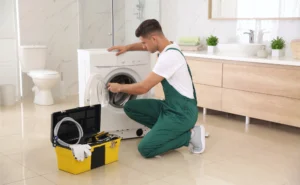Washing machines have become an indispensable part of our daily lives, simplifying the tedious task of laundry. However, when these trusty appliances encounter issues, the thought of repair might seem daunting. Fear not, as this DIY washing machine repair guide will empower you to fix common problems at home. With a bit of know-how and the right guidance, you can save both time and money.
In the world of appliance repair, a malfunctioning washing machine is a common challenge. Rather than panicking or immediately calling for professional help, consider taking matters into your own hands. AZ Repairing Dubai understands the value of DIY solutions, and we’re here to guide you through the process of repairing your washing machine at home.
Safety First
Before diving into the repair process, prioritize safety. Unplug the washing machine repair and ensure a safe working environment. Gather essential tools such as screwdrivers, pliers, and gloves. Safety glasses are also recommended, especially when dealing with electrical components.
Identifying the Problem
Understanding the root cause of the issue is the first step to an effective repair. Is your washing machine making strange noises, not spinning, or leaking water? Each symptom points to a specific problem, and accurate diagnosis is crucial. Consult the user manual for troubleshooting tips or search online resources for guidance.
Checking Power Supply
Start by examining the power supply. Ensure the washing machine is properly plugged in and that the electrical outlet is functioning. If the power cord or plug is damaged, it may need replacement. Exercise caution when handling electrical components and consider consulting a professional if you’re unsure.
Inspecting Water Supply
Water-related issues are common in washing machines. Check for clogs in the water inlet valve and inspect the drainage system for blockages. Ensure the hoses are properly connected and not leaking. Cleaning the inlet valve and hoses regularly can prevent future issues.
Examining Drum Issues
Strange noises or imbalances during the spin cycle often indicate problems with the washing drum. Open the door and inspect for loose items that might be causing the imbalance. If the issue persists, it may be a sign of worn-out drum bearings or suspension rods. Replacing these components can restore smooth operation.
Handling Agitator Problems
For top-loading machines, issues with the agitator can disrupt the washing process. If the agitator isn’t moving as it should, it might be a simple case of obstruction. Remove any lodged items and check for damage. If the agitator is still not working, it may need replacement, a task that can be done at home with the right tools.
Dealing with Pump Blockages
A clogged pump can lead to drainage problems and water not being expelled properly. Locate the pump and inspect it for debris. Remove any blockages carefully and ensure the impeller can move freely. Regularly cleaning the pump filter can prevent future clogs.
Belt and Motor Issues
Front-loading machines may experience belt or motor issues. Inspect the belt for signs of wear or damage and replace it if necessary. Motors can overheat or malfunction; troubleshoot by checking connections and ensuring proper ventilation. If problems persist, professional assistance may be required.
Final Checks and Testing
After addressing the specific issues, perform a thorough check of all components before reassembling the washing machine. Once reassembled, conduct a test cycle to ensure the problem is resolved. Be attentive to any unusual noises or vibrations, as these could indicate lingering issues.
Congratulations! You’ve successfully navigated the DIY washing machine repair process. By following the steps outlined in this guide, you’ve not only saved money but also gained valuable skills in appliance maintenance. Remember, AZ Repairing Dubai is here to support your DIY endeavors, and with a little confidence, you can tackle any washing machine issue that comes your way. Happy repairing!





